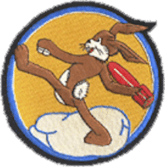463d Bombardment Squadron
The 463d Bombardment Squadron is an inactive United States Air Force unit. Its last assignment was with 346th Bombardment Group at Kadena Airfield, Okinawa, where it was inactivated on 30 June 1946. From 1942 the squadron served as a replacement training unit for heavy bomber aircrews. It was inactivated in the spring of 1944 in a general reorganization of Army Air Forces training units. The squadron was activated again in 1944 as a Boeing B-29 Superfortress unit. Although it deployed to the Pacific, it arrived too late to see combat service.
| 462d Bombardment Squadron | |
|---|---|
| Active | 1942–1944; 1944–1946 |
| Country | |
| Branch | United States Army Air Forces |
| Role | Bombardment |
| Part of | Eighth Air Force |
| Engagements | Pacific Ocean Theater |
| Insignia | |
| Patch with 461st Bombardment Squadron emblem (approved 8 March 1943)[1] |  |
History
Heavy bomber replacement training
The 463d Bombardment Squadron was first activated in July 1942 at Salt Lake City Army Air Base, Utah as one of the original squadrons of the 331st Bombardment Group. In September it moved to Casper Army Air Field, where it conducted Boeing B-17 Flying Fortress replacement training until 1943, when it converted to the Consolidated B-24 Liberator. Replacement training units were oversized units which trained aircrews prior to their deployment to combat theaters.[2] However, the Army Air Forces found that standard military units, based on relatively inflexible tables of organization, were not proving to be well adapted to the training mission. Accordingly, it adopted a more functional system in which each base was organized into a separate numbered unit,[3] while the groups and squadrons acting as replacement training units were disbanded or inactivated.[4] This resulted in the 462d, along with other units at Casper, being inactivated in the spring of 1944 and being replaced by the 211th AAF Base Unit (Combat Crew Training Station, Heavy), which assumed the 331st Group's mission, personnel, and equipment.[1][5]
Very heavy bomber operations
In August 1944, the squadron was reactivated as a Boeing B-29 Superfortress unit at Dalhart Army Air Field, Texas and assigned to the 346th Bombardment Group. It trained with Superfortresses at Dalhart and Pratt Army Air Field, Kansas until June 1945, when it began moving to Okinawa to become part of Eighth Air Force. Although the war ended before the squadron could begin operations, a few of its crews formed part of its forward echelon and flew missions with B-29 units of Twentieth Air Force.[6][1][7]
The squadron flew several show of force missions from Okinawa over Japan following VJ Day. It also evacuated prisoners of war from camps in Japan to the Philippines. The squadron was inactivated on Okinawa in June 1946.[1][7]
Lineage
- Constituted as the 463d Bombardment Squadron (Heavy) on 1 July 1942
- Activated on 6 July 1942
- Inactivated on 1 April 1944
- Redesignated 463d Bombardment Squadron, Very Heavy on 4 August 1944
- Activated on 18 August 1944
- Inactivated on 30 June 1946[1]
Assignments
- 331st Bombardment Group, 6 July 1942 - 1 April 1944
- 346th Bombardment Group, 18 August 1944 - 30 June 1946[1]
Stations
- Salt Lake City Army Air Base, Utah, 6 July 1942
- Casper Army Air Field, Wyoming, 15 September 1942 - 1 April 1944
- Dalhart Army Air Field, Texas, 18 August 1944
- Pratt Army Air Field, Kansas, 12 December 1944 - 29 June 1945
- Kadena Airfield, Okinawa, 13 August 1945 - 30 June 1946[1]
Aircraft
- Boeing B-17 Flying Fortress, 1942-1943, 1945
- Consolidated B-24 Liberator, 1943-1944
- Boeing B-29 Superfortress, 1945-1946
- Curtiss C-46 Commando, 1946[1]
References
- Notes
- Maurer, Combat Squadrons, pp. 569-570
- Craven & Cate, Introduction, p. xxxvi
- Goss, p. 75
- Maurer, Combat Units, p. 7
- Maurer, Combat Units, pp. 211-212
- Carman, Glenn. "346 Bomb Group". 346BombGroup.com. Retrieved 30 April 2017.
- Maurer, Combat Units, pp. 224-225
Bibliography
![]()
- Craven, Wesley F.; Cate, James L., eds. (1955). The Army Air Forces in World War II (PDF). Vol. VI, Men & Planes. Chicago, Illinois: University of Chicago Press. LCCN 48003657. OCLC 704158. Retrieved 17 December 2016.
- Goss, William A. (1955). "The Organization and its Responsibilities, Chapter 2 The AAF". In Craven, Wesley F.; Cate, James L. (eds.). The Army Air Forces in World War II (PDF). Vol. VI, Men & Planes. Chicago, Illinois: University of Chicago Press. LCCN 48003657. OCLC 704158. Retrieved 17 December 2016.
- Maurer, Maurer, ed. (1983) [1961]. Air Force Combat Units of World War II (PDF) (reprint ed.). Washington, DC: Office of Air Force History. ISBN 0-912799-02-1. LCCN 61060979. Retrieved 17 December 2016.
- Maurer, Maurer, ed. (1982) [1969]. Combat Squadrons of the Air Force, World War II (PDF) (reprint ed.). Washington, DC: Office of Air Force History. ISBN 0-405-12194-6. LCCN 70605402. OCLC 72556. Retrieved 17 December 2016.